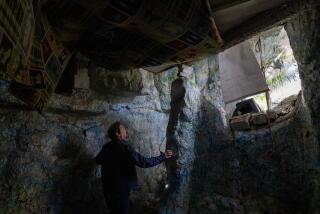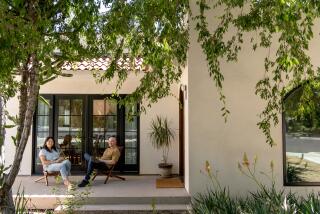Rolling Hills mansion that’s largely subterranean is going up for auction
In the mid-1990s, John Z. Blazevich was looking for a project. At the time, he was president of Contessa Premium Foods, a frozen-food manufacturer he founded in 1984, “and my dream was to build an architectural tribute to California, in the style of the Getty Villa or Hearst Castle,” he says.
After buying adjacent lots in Rolling Hills, on the Palos Verdes Peninsula, he began a construction process that lasted more than a decade.
First Blazevich knocked down the property’s existing home, living through the construction in a one-bedroom guesthouse that was completed in 1999. Three years later, he moved into the 51,000-square-foot main house, which was built primarily underground as a result of the community’s zoning restrictions. He named the property Hacienda de la Paz.
But after a few years he got antsy. Contessa had filed for bankruptcy in 2011 (it emerged from bankruptcy in 2013, paying creditors in full, according to a release), and “I had other projects I wanted to complete and other challenges I wanted to do,” says Blazevich, who was also chief executive of shrimp importer Viva Food Group.
So he put the 7.4-acre property on the market, listing it in June 2013 for $53 million.
“I wasn’t planning on it being sold right away,” he says. “I would have liked it to be, but I was living here and enjoying it.”
After three years, he took it off the market for a few months, then relisted it with a $5-million price cut. Yet the home still failed to find a buyer. This year its price was lowered again, this time to $40 million.
“The house is in immaculate shape,” Blazevich says. He acknowledges, though, that despite its moneyed inhabitants, “Rolling Hills isn’t a well-known area like Beverly Hills or Malibu,” which could deter buyers looking for a recognizable address to match the home’s price tag.
So he has made the relatively unusual decision to put the home up for auction, listing it with Concierge Auctions, a New York-based property auctioneer.
The auction will take place July 26 and has no reserve, meaning that technically, the home could sell for a small fraction of Blazevich’s initial listing price.
Asked how much he spent to build the property, in order to get some sense as to whether he’d be selling at a loss, Blazevich offers only: “I had no budget, and I exceeded it. That was pretty much it.”
Many of the costs associated with the property stemmed from Blazevich’s self-professed passion for the home-construction project.
“This project was not your typical residential home,” he says. “It was more like a commercial project” — not that many commercial projects involve a 10,000-square-foot underground hamam and spa, replete with a lap pool. (Blazevich says he oversaw the hamam’s construction in northern Africa before the parts were shipped to California to be reassembled: “We were in the desert in Morocco with 300 nomads,” he says.)
The house also has a 15,000-square-foot indoor tennis court whose walls are decorated with trompe l’oeil paintings. “You’ve seen tennis courts? Well, this one is styled as a ballroom,” he says. “I didn’t want to have a high-school-gym kind of look.”
There is also an outdoor clay tennis court with ocean views, along with an outdoor swimming pool.
Other costs came from Blazevich’s attention to detail. “Just think of the hardware,” he says. “I had molds made for the doors handles and hinges, embellished with the Hacienda de la Paz dove and olive branch,” a design he commissioned specifically for the house. “This wasn’t like you went shopping at Home Depot.”
In total, the property has nine bedrooms and 25 bathrooms, along with multiple elevators, a gym, a wine cellar, a bocce court and a six-car garage.
The listing agents are Jade Mills of Coldwell Banker Residential Real Estate and Jason Oppenheim of the Oppenheim Group.
“This estate would be almost impossible to reproduce today, even if someone had the passion to attempt it, as it would likely take almost a decade and cost more than $100 million,” Oppenheim said.
“Hacienda de la Paz is one of the most unique and meticulously crafted properties in the United States.”
Auctions are an increasingly popular method for selling houses that have proved impossible to sell through traditional means. By putting the house at the mercy of an immediate bidding process, a seller, in effect, is letting the market decide what it’s worth.
But it’s not a free-for-all. “When bidders register to bid on this property, there’s incentive for them to tender an opening bid,” explains Chad Roffers, the chairman of Concierge Auctions. That incentive, he continues, is substantial: Concierge Auctions charges a 12% premium on all sales, but when a qualified buyer tenders an opening bid before the sale, that 12% premium is paid by the seller, not the buyer.
Moreover, if the bidding exceeds a buyer’s opening bid, the buyer pays only a 12% premium on the difference between the opening bid and the sales price. If a buyer places an opening bid of $20 million and wins at $30 million, that buyer would pay a premium on only $10 million, thereby saving $2.4 million.
The auction house, in other words, is able to line up offers on the house before the sale. And if there aren’t enough qualified offers ahead of time? “We reserve the right to cancel the sale” before it begins, Roffers says.
Blazevich is mum as to what he thinks the home is actually worth. “I guess on the day of the auction we’re going to find that out,” he says.






